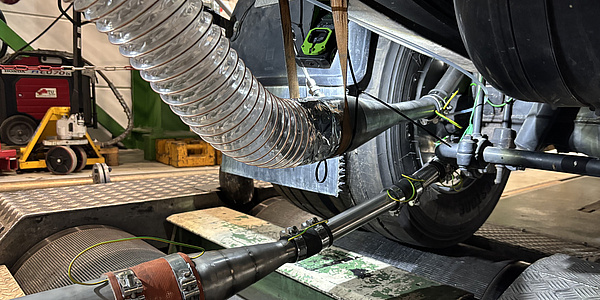Safe Batteries for our Safe Everyday Life

Batteries are an essential part of our everyday life and central element of a sustainable environment. If we are serious about switching to renewable energy sources on a large scale, where availability fluctuates as with wind and solar power, then we need to be in a position to store the green electricity generated both in the short and long term. One possible solution is batteries with different capacities. The technology is not new and is already in widespread use today. However, the more applications that batteries are used in, and the better their performance – especially in everyday applications like mobility – the greater the demands placed on them in terms of safety, too. TU Graz is conducting wide-ranging research into this area at various institutes and research centres.
Battery Safety Center
Crushing batteries, crashing them into walls, pressing, squeezing, and stressing them to the point of failure – all in a day’s work for the Battery Safety Centre at TU Graz. The aim of these tests is to explore the limits of a battery's resilience under different environmental conditions, and establish precise metrics. This is done with charged and uncharged batteries of various ages and with different “pasts” – i.e. exposure to different stresses during their working lives.
Next year, the centre will add a new test rig that will yield new research findings, particularly in the areas of mechanical stress and battery characterisation. This allows it to apply pressure precisely to batteries in order to simulate situations such as the conditions in a battery pack in an electric vehicle. The batteries can then be charged and discharged or electrical parameters can also be determined in order to investigate the effects. “But we can test much more with it than that. Thanks to a sophisticated measuring system and test bench design, we also achieve a very high level of measurement accuracy, which will exceed that of our current test benches many times over and enable us to generate even more precise data for our simulation models,” says Jörg Moser, who heads the centre.
Play video
Battery4Life
The aim of the Comet-Zentrums Battery4Life is to make batteries safe to use in the long term, with a focus on lithium-ion batteries. Research is conducted at various levels at the centre: in the area of analysis and optimisation, the behaviour of energy storage devices under high loads is investigated. In addition, a close look is taken at degradation, i.e. the ageing of batteries, with a particular focus on how age affects operational safety. Continuous monitoring of the batteries is also central to safe long-term operation in their first and second lives. The centre aims to develop new measurement procedures and qualification methods for this purpose. In summary, the researchers are pursuing a multi- and interdisciplinary approach to battery safety.
T-Cell-Dummy
It goes without saying that there are extensive safety precautions in place at research facilities such as the Battery Safety Centre – as you would expect, given that they are used to test batteries to their absolute limits. At these facilities, everything revolves around the battery itself, but batteries are also relevant in many other areas of research, albeit not the central focus. As an example, cooling systems need to be in working order while also taking into account heat generation in a battery cell or battery pack. At the Institute of Thermodynamics and Sustainable Propulsion Systems, something called a T-Cell dummy is being researched for such cases. “It’s a classic cylindrical cell, but inside it consists only of a heating foil and electronics,” explains project lead Eberhard Schutting. “This allows us to simulate heat generation while eliminating the risk sources that could lead to chemical reactions and fires under extreme stress.” The surface of the cell dummy heats up like a conventional battery. Coupling the dummy with a sophisticated simulation that runs in the background on the test rig enables battery operation to be replicated precisely.
Institute of Process and Particle Engineering Investigates Thermal Runaway
Thermal runaway is the term for the uncontrolled overheating of battery cells that triggers a dangerous chain reaction. The stored energy is released suddenly as hot gas and a mist of tiny particles. This issue will grow in importance as batteries become more powerful and are able to store more energy per charge. After all, the more powerful the battery, the more dangerous thermal runaway becomes. Particle mist can generate an electric arc – i.e. Lightning, similar to a thunderstorm – within the battery pack, which has the potential to ignite an uncontrollable fire.
The Institute of Process and Particle Engineering is investigating this phenomenon and ways to prevent it. The goal is to provide engineers with simulation tools, new testing methods, safety instructions and guidelines.
Understanding the materials
Also at the Institute of Process and Particle Engineering, the materials used in batteries are being studied to gain deeper insights into their behaviour. In one project, methods are being explored to simulate the movement and flow behaviour of irregularly shaped particles, such as the ones found in batteries and battery Recycling processes. To simulate these particles, a shape was sought that best matches their behaviour. Ultimately, the tetrapod – which neatly replicates how non-spherical particles become wedged or entangled when flowing – was identified. This is particularly relevant for battery recycling.
At the Institute of Materials Physics, battery materials are also being investigated. In particular, the aim is to gain insights into charging and discharging processes for lithium-ion and sodium-ion batteries, through the use of magnetic measurement methods.
This makes use of the fact that the typical cathode of such a battery consists of a transition metal oxide that is oxidised or reduced during charging and discharging. These electrochemical processes can be sensitively tracked using a magnetometer in a specially developed measuring setup.
More Safety
Together, the various research approaches and projects are contributing to greater safety for our energy storage systems.
Play video




